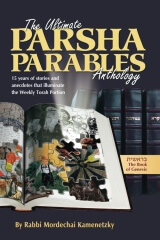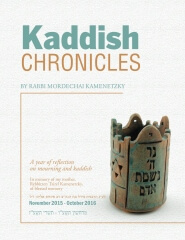
After 210 years on foreign soil, many filled with sadistic slavery, the Jewish people get a taste of freedom. The Egyptian oppressors are devastated with plagues, and the Jews are readied for freedom. But before they are released, they are charged with two mitzvos. The sanctification and establishment of the New Moon, and the laws of the Korbon Pesach (Passover Lamb). These mitzvos entail some of the most complex statutes in the entire realm of Jewish law. Establishing new months and setting the calendar entails knowledge of astronomical calculations and celestial sophistication that was hardly a charge for a slave nation! The laws of the Passover sacrifice are defined in intricate detail, not only pertaining to its preparation, but the way the sacrifice is eaten, and who may partake of it.
First, the Torah tells us that the offering may only be eaten with those who have been pre-designated as members of the festive meal. The Torah also instructs that the lamb must be wholly roasted, not one piece may be pan-fried or boiled. The Torah also commands how the lamb is eaten. It must be eaten in a rush — after all, the Jews were about to exit Egypt — and there was no time for long, drawn-out festivities. In fact, the Torah tells the nation to eat the korbon with their back packs readied and their staffs in hand! The instructions continue. “You must not break a bone. Do not leave over any meat.” The lamb was to be eaten meticulously, every bit of meat was to be finished, yet no one was allowed to sink their teeth into it to the extent that the tender lamb’s bone would break.
One may ask: Why is the introduction to Judaism so abstruse and replete with detail? After all, the nation had been slaves for 210 years! Time was never a factor, let alone a lunar calendar. They probably never ate meat, the god of the Egyptians, for the duration of that time. Why not as soon-to-be free men were they not allowed to indulge the way they wanted, in high style and with unmitigated freedom? Why is the first allowance of carnivorous cuisine so restricted and detailed? Shouldn’t the first commands to a fledgling people be simple feel-good symbolism?
Dr. Viktor E. Frankel was a longtime prisoner in the bestial concentration camps of Nazi Germany. His parents, brother, and wife were killed and cremated in the ovens. Yet as a psychiatrist he devised a method of survival through the ravages of sadistic barbarism, detailed in his work, Man’s Search for Meaning. He writes that though the Nazi’s goal was to every eradicate every human trait, “hunger, humiliation, fear and deep anger are rendered tolerable by closely guarded images of beloved persons, by religion, and even by the healing beauties of a tree or a sunset.” Frankel describes how he learned to relish every physical and spiritual entity he could grasp. These small acts would elevate their humanity. Scraps of wood formed pieces of meaningful art. He would analyze in his few free seconds every bit of good that was left to his existence.
One evening a fellow prisoner rushed into the barracks and asked him to run out to the assembly grounds to watch the beautiful sunset. He whole sky became alive with clouds of ever-changing shapes and colors, from steel-gray to blood-red. They watched the contrast of the majestic billows compared to the muddy-brown earth-tethered huts. After minutes of moving silence the prisoners turned to each other, “how beautiful the world could be.”
Every nuance of life is actually filled with spiritual opportunities. By affording the nation two initial two commands that were replete with thousands of details, later expounded upon through thousands of pages of Talmudic and Halachic literature, The Holy One opened a new outlook to the formerly bonded. The moon that they watched for 210 years now became the embryo of spirituality. The sign of its lumens would herald the New Year and the Festivals. The experience of eating meat would become a royal meal filled with mitzvos and responses to Hashem’s command. There would be no chomping at bones like barbarians. Cooked in a precise and instructed manner, every step of a seeming earthly – even physical — act took on a magnificent sense of spirituality. Those most intricate, detail and sophisticated acts forged slaves into princes. Every detail was filled with spirituality and cognizance. There were messages of dignity, of restraint. No more were they starving prisoners grabbing any available food. These prisoners needed to reserve a place to dine. The slow means of preparation entailed finesse and patience; not one morsel was allowed to be eaten raw. Instead of grabbing the food and sinking their teeth straight to the bone, they were warned, do not shatter a bone! And they could not nibble at it and leave some over, as they were commanded not to leave any meat over. In the minutest detail there is great magnitude. And in the magnitude of those actions lie the magnitude of man who recognizes the magnitude of his Creator. Good Shabbos (c)1999 Rabbi Mordechai Kamenetzky
Dedicated by Peter & Donna Kash in honor of the anniversaries of their parents Robert & Leona kash and Herb & Marilyn Friedman
Copyright © 1998 by Rabbi M. Kamenetzky and Project Genesis, Inc.
If you enjoy the weekly Drasha, now you can receive the best of Drasha in book form!
Purchase Parsha Parables – from the Project Genesis bookstore – Genesis Judaica – at a very special price!
The author is the Dean of the Yeshiva of South Shore.
Drasha is the e-mail edition of FaxHomily, a weekly torah facsimile on the weekly portion
which is sponsored by The Henry and Myrtle Hirsch Foundation
Books by Rabbi Mordechai Kamenetzky:
 |
 |


